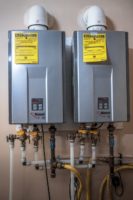Propane heating systems have an edge when it comes to comfort, efficiency, and emissions On average, more than half of a household’s annual energy consumption is used for space heating and air conditioning, according to the U.S. Energy Information Administration (EIA). Seasonal and energy-intensive uses can vary based on geographic location, home size and structure Read more
energy savings

Propane heating systems have an edge when it comes to comfort, efficiency, and emissions
On average, more than half of a household’s annual energy consumption is used for space heating and air conditioning, according to the U.S. Energy Information Administration (EIA).
Seasonal and energy-intensive uses can vary based on geographic location, home size and structure, and energy sources used. Because of higher space-heating demand, homes in the Northeast and Midwest regions consume more energy on average than homes in the South and West regions, for example. Additionally, larger homes and families tend to use more energy overall than smaller households.
There are more options than ever for home heating, and there are several different factors to take into consideration when selecting the best system for your customers. Whether your customers are looking to reduce energy consumption and costs, decrease their carbon footprint, or enjoy more comfortable home heating, propane-powered systems can provide a reliable solution for homeowners across the country. According to data from the Propane Education & Research Council (PERC), more than 7.5 million households rely on propane for primary or secondary home heating.
Here are three key advantages of propane-powered systems to share with your customers next time they ask about home heating solutions.
Homeowners can save more on energy costs with propane
The efficiency of a home heating system can greatly impact its utility costs. For homeowners looking to reduce their energy consumption — and their bills — high-efficiency propane furnaces are a great choice. Propane furnaces offer best-in-class efficiency, with ratings from 90 to 98 percent. Further, ENERGY STAR-qualified propane furnaces are up to 15 percent more efficient than standard propane models and can save up to $75 in energy costs each year, according to data from PERC.
In a comparative analysis of residential heating systems, Newport Partners, LLC examined the performance of seven heating systems in 16 different locations for new and existing homes. Each system was analyzed and compared in terms of its first cost, energy cost, emissions, and simple payback period. The research revealed several cost advantages to selecting a propane furnace, including low annual energy costs. Notably, the annual energy costs of a high-efficiency propane furnace were $1,650, which is 10 percent lower than standard-efficiency ASHPs and 14 percent lower than heating oil furnaces. When used as a backup for an air- or ground-source heat pump system in the place of electric heating coils the efficiency of the systems is also improved and further protects homeowners from rising utility costs when temperatures drop.
Beyond annual energy costs, propane systems offer more competitive upfront costs and payback periods, too. High-efficiency propane furnaces typically cost less to purchase and install than heating oil and ground-source heat pump systems. Additionally, homeowners purchasing a high-efficiency propane furnace for a new home in a cold climate could recoup their initial costs in two years due to low equipment and energy costs. By contrast, it could take a homeowner more than 20 years to recoup the initial cost of a ground source heat pump system through energy savings.
Propane systems provide warmth and comfort
Comfort can often be a deciding factor for homeowners. They want systems that can provide comfortable, consistent heat. Fortunately, propane furnaces are perfect for eliminating cold pockets in a home. These systems heat air to a higher initial temperature, getting to a homeowner’s desired temperature faster and maintaining it more effectively.
Because propane-powered furnaces heat air to 115–125 degrees Fahrenheit, they make the indoor air feel warmer and more consistent than heat from air source heat pumps (ASHPs), which often supply temperatures lower than 100 degrees Fahrenheit and are more affected by cold outdoor temperatures.
Propane systems support environmentally-conscious customers
When making decisions for homeowners heating systems remember those customers are placing more of a priority on reducing their carbon footprint. One way that homeowners can decrease emissions is by having their home’s systems and appliances run on propane instead of electricity.
According to data from PERC, residential propane furnaces can emit up to 50 percent fewer greenhouse gas emissions than electric furnaces and 12 percent fewer greenhouse gas emissions than fuel oil furnaces. Further, propane-powered furnaces produce up to 35 percent fewer nitrogen oxide (NOx) emissions and 82 percent fewer sulfur oxide (SOx) emissions than electric furnaces. And in colder and mixed climates, high-efficiency propane-fueled furnaces produce at least 26 percent fewer carbon dioxide emissions compared to standard-efficiency electric air-source heat pumps. It is extremely important for you to be prepared to educate your customers about these differences and not leave them out in the cold.
To learn more about the benefits of propane heating systems, visit Propane.com/Furnaces-Boilers.
 Bryan Cordill is director of residential and commercial business development for the Propane Education & Research Council. He can be reached at bryan.cordill@propane.com.
Bryan Cordill is director of residential and commercial business development for the Propane Education & Research Council. He can be reached at bryan.cordill@propane.com.

Forced air is still the traditional method of heating homes, but radiant heat is gaining significant momentum as an alternative. According to HGTV, the growth rate of in-floor radiant heating systems was estimated at 30 to 50 percent per year. At the heart of this shift is not just one single benefit. It’s a variety of advantages Read more
Forced air is still the traditional method of heating homes, but radiant heat is gaining significant momentum as an alternative. According to HGTV, the growth rate of in-floor radiant heating systems was estimated at 30 to 50 percent per year.
At the heart of this shift is not just one single benefit. It’s a variety of advantages that radiant floor heating systems bring to the table, the combination of which enhance the daily lives of a home’s occupants:
Even Heat Distribution
When a house is heated by a forced-air system, it will always be warmest near the vents that distribute the air. This can lead to “hotspots” on one end of a room while the other side of the room remains cool. And because hot air rises, upstairs rooms will be warmer than those downstairs.
With radiant floor heating systems, homeowners control how heat circulates in their home. Rather than heating the surrounding air, the heat that radiates from the floor warms other objects in the room and is evenly distributed without the potential for heat loss.
Improved Air Quality
While air pollution is more often associated with the outdoors, indoor air can be dirty as well. Whether it’s dust, pet dander or chemicals from fragrances (among other sources) that pollute the air, forced-air systems exacerbate the problem for allergy sufferers. That’s because the forced, heated air will stir up and mix with these airborne particles.
Since radiant floor heating systems don’t move air to deliver heat, the circulation of indoor particles is minimized. With less pollutants blown around, indoor air quality improves, which benefits allergy sufferers.
No Ductwork
The ductwork in forced-air systems further contributes to air pollution. When it’s riddled with cracks and holes, more dust and odors can enter and circulate. Without proper insulation, these same cracks and holes can cause air to leak out of the system and hinder its overall efficiency.
With no ducts, radiant floor heating systems reduce the churn of dust and allergens while curtailing heat loss. The absence of ducts means less work for homeowners as it eliminates the need for repairs like cleaning out ducts clogged with particles or adding insulation when heat loss mounts.
Energy Savings
With their uneven distribution of heat and potential for heat loss, traditional heating systems can be energy hogs.
Depending on how well a house is insulated, radiant floor systems can save up to 30 percent compared to forced-air systems. In terms of bills, the impact is quite significant as space heating is the largest energy expense for the average U.S. home, accounting for around 45 percent of energy bills.
Noiseless Operation
Homes should be quiet, but forced-air systems can be noisy as furnaces cycle on and off, gaps in the ductwork whistle and loose parts rattle.
By comparison, radiant floor heating systems are exceptionally quiet.
As consumers learn more about the advantages of radiant heating, its popularity will continue to grow.
 Josh Quint is product manager, heating and cooling, for Viega LLC.
Josh Quint is product manager, heating and cooling, for Viega LLC.
